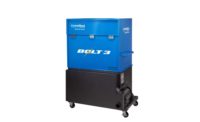
In 2011, Bill Chaleff, of Chaleff & Rogers Architects, came to Community Environmental Center (CEC) with a challenging situation. Chaleff’s client, who owned a vintage mansion in Southampton, Long Island, wanted to repair the house and wanted a sustainable solution for insulating the exterior walls so that the original interior plaster faces of the walls could be preserved.
The problem: It was January and icy temperatures blanketed the northeast. Damp-spray cellulose, which CEC ordinarily would have recommended, would freeze from exposure to the cold weather.
CEC’s solution: Dry, dense-pack cellulose.

That cosmetic concern on the part of the client was what triggered the renovation, but it evolved into a heavy-duty maintenance regimen. Ultimately, says Chaleff, whose Eastern Long Island firm has been specializing in sustainable architecture for 35 years, “The project included remediation on some of the structure, installing a proper weather barrier and drainage plane, replacing the leakiest kinds of windows you can imagine and adding flashing to insure the integrity of the structure into the future.”

New solutions in place of old fixes
As for insulation, the building had been treated in the past with blown-in and batt fiberglass in many places (which Chaleff removed) and in other places there was no insulation at all.Originally he had envisioned blowing damp-spray cellulose into open walls against the backs of the house’s plaster walls. But Community Environmental Center, a Queens-based non-profit that provides energy efficient retrofits to buildings in the New York Metropolitan Area, advised blowing in dry, dense-pack cellulose manufactured by FiberAmerica. The dry cellulose would not freeze in the open bays and it would provide optimal insulation once the walls were closed up.
Furthermore, if damp-spray had been applied from the exterior, the overspray would have gone into the landscape where it would have been difficult to recover for recycling and reuse.
CEC primarily uses cellulose to insulate walls from the inside. In fact, CEC has been working with both dry and damp-spray cellulose for years, finding that buildings insulated with cellulose reduce air infiltration by 25-40 percent over traditional fiberglass insulation and thus require less energy to heat and cool. In addition, cellulose does not deteriorate, retards fire (it has a Class-A noncombustible rating) and vermin can’t stand the stuff.

So the Chaleff-CEC team decided to wrap the building with what Chaleff calls “a very tough membrane, which had a reinforced scrim in it.” This permeable, translucent, polyethylene wrap allowed CEC’s cellulose installers to see and reach the cavities they were filling and the polyethylene wrap (from Par/Pac Inc.) also prevented the dry cellulose from blowing out past the line of sheathing and siding. By closing the outside of the stud cavities with a translucent wrap, holes could be made in the wrap and the dry dense-pack cellulose could be blown into each cavity and easily inspected.
Out with the old
Before installing the vapor-permeable wrap, Chaleff’s workers stripped everything open and gutted the bays, removing all the old insulation and skinning any old nails from the beams. Then they closed the walls temporarily with plywood until CEC’s seven-person crew arrived to attach the vapor-permeable wrap and blow in the cellulose.
“We used a truckload of staples,” says Chaleff. “If you look carefully at the photos, it’s clear that the staples are virtually stitched edge-to-edge.”
Once the vapor-permeable wrap for a section was in place the entire process moved swiftly. Despite the wind and cold, CEC completed the insulation in a total of five days, stopping periodically to allow Chaleff’s workers to prepare another section of wall. The majority of the cavities were 5-inches deep, but other bays were 8- to 9-inches deep. The crew installed at least 3 ½ pounds of dense-pack per cubic foot.

In with the new
For Chaleff, the dense-pack solution was ideal. “We wanted to create a wall that was free to dry to both the interior and the exterior,” he says. “We were looking for thermal symmetry in the wall’s design and construction: the building would experience both heating and AC loads, so putting a vapor barrier on one side or the other would be wrong for half the time. Traditionally a vapor barrier is put on the inside for the heating season, which means it would be in the wrong place during the cooling season. It doesn’t matter that our cooling season is short. What is of concern is that there is a cooling season which could cause condensation within the wall cavity and result in mold, mildew and even structural damage. A vapor-permeable wall construction avoids those problems completely.”“As far as I know,” says Chaleff, “cellulose is the only product that will give you the moisture wicking that protects and safeguards a building from leaks and moisture infiltration. Cellulose defuses the moisture throughout the entire bay, allows it to dry and keeps the moisture in the framing below the danger point of 19 percent.”

Bonus features, such as the thorough and effective sealing of all voids and use of a 100 percent recycled and totally benign material, are the frosting on the cake. As we turn the world of building and construction around to be more in line with the principles of sustainability then use of dense-pack cellulose and its brother, damp-spray, will be major players in the solution.



Report Abusive Comment